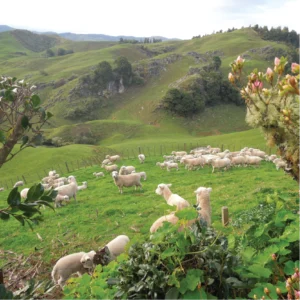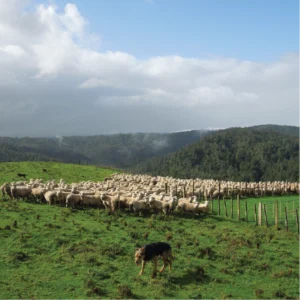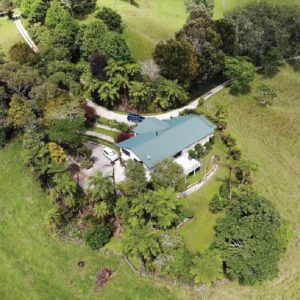Glenview Station: Where Adaptation, Action, and Aesthetics Cultivate a Legacy
In the heart of New Zealand’s North Island, nestled within the unique landscape surrounding the Waitomo Caves, lies Glenview Station. This isn’t any old farm; it is 2,100 acres of living, breathing testament to thoughtful adaptation, dedicated guardianship, and a deep connection to the natural world. Here, amidst rolling hills shaped by limestone and sandstone, Warren and Cindy Clayton-Green cultivate not just some of the world’s best lamb but a thriving legacy.

Glenview sits in a high-rainfall area, a defining characteristic of the western North Island of New Zealand. This abundant moisture nourishes lush pastures but also demands constant vigilance. As Warren explains, farming here requires managing “pastures and our soil fairly carefully.” This careful management at Glenview offers insight into the integrity and commitment behind Atkins Ranch’s world-leading products.
When Warren and Cindy arrived at Glenview Station 45 years ago, they intuitively saw the effects of the high stock numbers, resulting from a focus primarily on breeding stock. But the unique conditions at Glenview, the soil type, and the rainfall patterns soon prompted a rethink. The land itself guided them towards an evolution in their approach.
Embracing Change: The Rewards of Finishing and Flexibility
The Clayton-Greens transitioned from focusing solely on breeding to a dynamic system combining both breeding and finishing. This wasn’t just a change on paper; it was a fundamental shift driven by the environment. “I find it’s more enjoyable farming,” Warren shares candidly, “because you’re seeing your progeny to its end result.”
Beyond personal satisfaction, this combined model brought crucial practical advantages. By incorporating finishing, they naturally reduced pressure on the ecosystem. This seemingly simple change unlocked significant adaptability. “With having fewer numbers because you’re finishing, you’re more adaptable in dry or really wet conditions,” Warren notes.
In a climate prone to extremes, this flexibility is invaluable. During exceptionally wet winters, they can manage stock movement to protect pastures and fragile soil. In dry summers, they have more capacity to adjust without overburdening the land. “I don’t try and chew it out too much if it’s getting quite dry,” Warren states. Livestock are moved according to conditions, ensuring the long-term health of the grass, the vital resource underpinning the 100% grass-fed promise Atkins Ranch stands by.
Guardians of Soil, Stream, and Stock
 The health of Glenview begins with the soil and the pasture it supports. Rotational grazing is key. This careful choreography ensures pastures have time to recover, maintaining “better pasture lengths.” As Warren points out, good pasture length does more than just provide feed; it actively helps “stop as much runoff in heavy rainfall,” protecting the soil from erosion, keeping nutrients on the farm and protecting precious waterways. This meticulous attention to detail ensures the animals always have access to the highest quality grass feed.
The health of Glenview begins with the soil and the pasture it supports. Rotational grazing is key. This careful choreography ensures pastures have time to recover, maintaining “better pasture lengths.” As Warren points out, good pasture length does more than just provide feed; it actively helps “stop as much runoff in heavy rainfall,” protecting the soil from erosion, keeping nutrients on the farm and protecting precious waterways. This meticulous attention to detail ensures the animals always have access to the highest quality grass feed.
Their guardianship extends explicitly to the waterways weaving through the property. Recognizing the critical importance of clean water, the Clayton-Greens have invested significantly in water reticulation. In the front “fattening country,” roughly half the paddocks are serviced by a dedicated water system. Further into the backcountry, three additional systems pump water to the paddocks at a higher elevation – Glenview sits at 1,500ft at its highest point. The goal is clear: “so the stock doesn’t have to go down to the streams to get water.” The animals appreciate it – “they certainly use those troughs,” Warren confirms. This proactive investment keeps stock out of sensitive waterways, protecting water quality and riparian ecosystems, a tangible demonstration of the sense of guardianship seen across all Atkins Ranch farmers.
Planting a Greener Future
As you gaze out across the vast expanse of Glenview Station, you see a landscape actively managed for the future. The Clayton-Greens maintain an extensive planting schedule. For Warren, planting is a labor of love with multi-faceted benefits, shade for animals during the hot summers, land stability in the steeper country, and not least of all, the aesthetic of the farm, an element that is very important to Warren. Warren is acutely aware Glenview Station is a dramatic piece of paradise, with beautiful clear waterways, and cave systems carved into the limestone rock formations. This is a very special part of the world, and the Clayton-Greens understand the role they play in enhancing it for future generations.
Alongside these plantings, Warren estimates they have fenced off approximately “a third of the farm’s native bush.” This isn’t just scrubland; it is the heartbeat of the property, with “quite a bit of that” protected permanently under QEII National Trust covenants.
For Warren, this extensive environmental work offers dual benefits. He has a clear appreciation for the visual appeal: “I prefer native plants if I can… because they fit into the aesthetics of the place. I think aesthetics is fairly important.” Even the practical poplars, he notes, “will be aesthetically attractive as well as holding the hills.” It’s a philosophy he sums up perfectly: “it’s a win-win for me to look at the place and also for the soil.” This integration of ecological health, practical benefit, and visual beauty is central to Glenview’s approach to producing high quality lamb.
 Ultimately, though, it’s the connection to the land itself that shines through. “Cindy and I really enjoy our farm,” Warren states proudly, adding with a touch of wry humor that the physical work “certainly makes going to bed at night pretty easy.” There’s an undeniable energy in his description of the process: “the more you’ve done, the more you’ll end up doing because it’s quite addictive and it’s enjoyable seeing the end results.” This deep satisfaction comes from witnessing the fruits of their labor.
Ultimately, though, it’s the connection to the land itself that shines through. “Cindy and I really enjoy our farm,” Warren states proudly, adding with a touch of wry humor that the physical work “certainly makes going to bed at night pretty easy.” There’s an undeniable energy in his description of the process: “the more you’ve done, the more you’ll end up doing because it’s quite addictive and it’s enjoyable seeing the end results.” This deep satisfaction comes from witnessing the fruits of their labor.
Building A Legacy: The Glenview Commitment
The story of Warren and Cindy Clayton-Green at Glenview Station powerfully illustrates the values underpinning Atkins Ranch. It’s a story of continuous adaptation to work with nature, not against it. Glenview represents a place where thoughtful management, environmental integrity, and genuine passion result in exceptional output. The care for the soil, water, and pasture translates directly into the health of the animals and the purity of the 100% grass-fed product. The long-term vision, demonstrated by decades of fencing and planting, assures consumers this commitment is deeply rooted and built to last.
As Warren looks towards the horizon, contemplating the future of Glenview, there’s a humble hope: “the next generation presumably will carry on with it.” It’s a sentiment that speaks volumes about their purpose: to nurture not just a successful farm, but a thriving, sustainable legacy. It’s this commitment, woven into the fabric of Glenview Station, that echoes in the quality and integrity of Atkins Ranch lamb, connecting dedicated New Zealand farmers with appreciative consumers across America.
*Finishing refers to the final stage of raising an animal before it goes to market. The main goals of the finishing phase are:
- Weight Gain: Ensuring the animal reaches a specific target live weight suitable for the market.
- Conditioning: Achieving the desired level of fat cover and muscle development to meet quality grades.
- Efficiency: Often involves specific feeding strategies to achieve the target weight and condition efficiently.